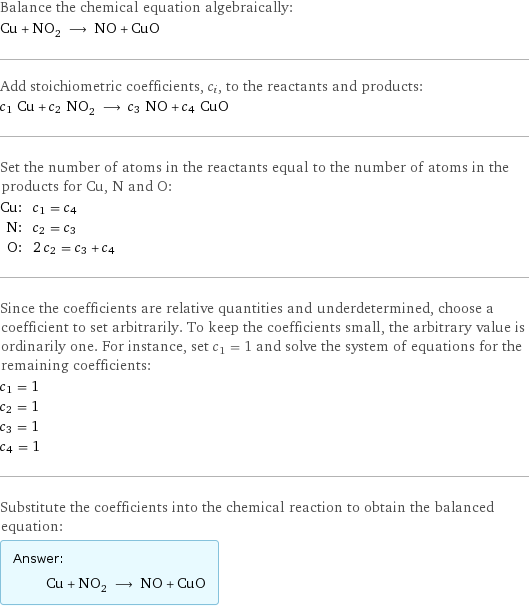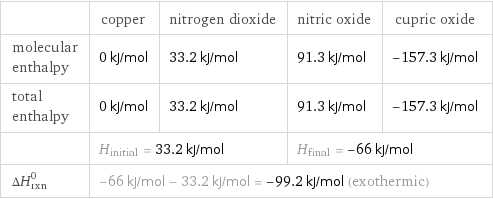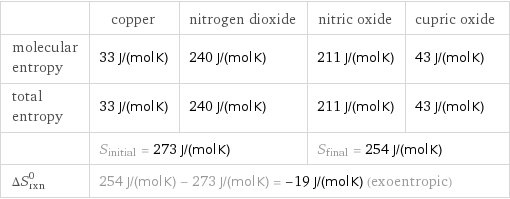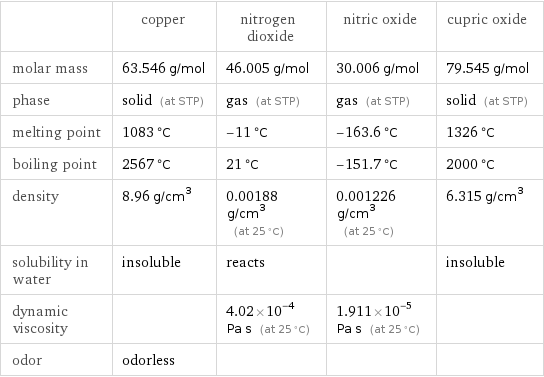Input interpretation

Cu copper + NO_2 nitrogen dioxide ⟶ NO nitric oxide + CuO cupric oxide
Balanced equation

Balance the chemical equation algebraically: Cu + NO_2 ⟶ NO + CuO Add stoichiometric coefficients, c_i, to the reactants and products: c_1 Cu + c_2 NO_2 ⟶ c_3 NO + c_4 CuO Set the number of atoms in the reactants equal to the number of atoms in the products for Cu, N and O: Cu: | c_1 = c_4 N: | c_2 = c_3 O: | 2 c_2 = c_3 + c_4 Since the coefficients are relative quantities and underdetermined, choose a coefficient to set arbitrarily. To keep the coefficients small, the arbitrary value is ordinarily one. For instance, set c_1 = 1 and solve the system of equations for the remaining coefficients: c_1 = 1 c_2 = 1 c_3 = 1 c_4 = 1 Substitute the coefficients into the chemical reaction to obtain the balanced equation: Answer: | | Cu + NO_2 ⟶ NO + CuO
Structures

+ ⟶ +
Names

copper + nitrogen dioxide ⟶ nitric oxide + cupric oxide
Reaction thermodynamics
Enthalpy

| copper | nitrogen dioxide | nitric oxide | cupric oxide molecular enthalpy | 0 kJ/mol | 33.2 kJ/mol | 91.3 kJ/mol | -157.3 kJ/mol total enthalpy | 0 kJ/mol | 33.2 kJ/mol | 91.3 kJ/mol | -157.3 kJ/mol | H_initial = 33.2 kJ/mol | | H_final = -66 kJ/mol | ΔH_rxn^0 | -66 kJ/mol - 33.2 kJ/mol = -99.2 kJ/mol (exothermic) | | |
Entropy

| copper | nitrogen dioxide | nitric oxide | cupric oxide molecular entropy | 33 J/(mol K) | 240 J/(mol K) | 211 J/(mol K) | 43 J/(mol K) total entropy | 33 J/(mol K) | 240 J/(mol K) | 211 J/(mol K) | 43 J/(mol K) | S_initial = 273 J/(mol K) | | S_final = 254 J/(mol K) | ΔS_rxn^0 | 254 J/(mol K) - 273 J/(mol K) = -19 J/(mol K) (exoentropic) | | |
Equilibrium constant
![Construct the equilibrium constant, K, expression for: Cu + NO_2 ⟶ NO + CuO Plan: • Balance the chemical equation. • Determine the stoichiometric numbers. • Assemble the activity expression for each chemical species. • Use the activity expressions to build the equilibrium constant expression. Write the balanced chemical equation: Cu + NO_2 ⟶ NO + CuO Assign stoichiometric numbers, ν_i, using the stoichiometric coefficients, c_i, from the balanced chemical equation in the following manner: ν_i = -c_i for reactants and ν_i = c_i for products: chemical species | c_i | ν_i Cu | 1 | -1 NO_2 | 1 | -1 NO | 1 | 1 CuO | 1 | 1 Assemble the activity expressions accounting for the state of matter and ν_i: chemical species | c_i | ν_i | activity expression Cu | 1 | -1 | ([Cu])^(-1) NO_2 | 1 | -1 | ([NO2])^(-1) NO | 1 | 1 | [NO] CuO | 1 | 1 | [CuO] The equilibrium constant symbol in the concentration basis is: K_c Mulitply the activity expressions to arrive at the K_c expression: Answer: | | K_c = ([Cu])^(-1) ([NO2])^(-1) [NO] [CuO] = ([NO] [CuO])/([Cu] [NO2])](../image_source/fd76d217a291d37644fb030b84d97603.png)
Construct the equilibrium constant, K, expression for: Cu + NO_2 ⟶ NO + CuO Plan: • Balance the chemical equation. • Determine the stoichiometric numbers. • Assemble the activity expression for each chemical species. • Use the activity expressions to build the equilibrium constant expression. Write the balanced chemical equation: Cu + NO_2 ⟶ NO + CuO Assign stoichiometric numbers, ν_i, using the stoichiometric coefficients, c_i, from the balanced chemical equation in the following manner: ν_i = -c_i for reactants and ν_i = c_i for products: chemical species | c_i | ν_i Cu | 1 | -1 NO_2 | 1 | -1 NO | 1 | 1 CuO | 1 | 1 Assemble the activity expressions accounting for the state of matter and ν_i: chemical species | c_i | ν_i | activity expression Cu | 1 | -1 | ([Cu])^(-1) NO_2 | 1 | -1 | ([NO2])^(-1) NO | 1 | 1 | [NO] CuO | 1 | 1 | [CuO] The equilibrium constant symbol in the concentration basis is: K_c Mulitply the activity expressions to arrive at the K_c expression: Answer: | | K_c = ([Cu])^(-1) ([NO2])^(-1) [NO] [CuO] = ([NO] [CuO])/([Cu] [NO2])
Rate of reaction
![Construct the rate of reaction expression for: Cu + NO_2 ⟶ NO + CuO Plan: • Balance the chemical equation. • Determine the stoichiometric numbers. • Assemble the rate term for each chemical species. • Write the rate of reaction expression. Write the balanced chemical equation: Cu + NO_2 ⟶ NO + CuO Assign stoichiometric numbers, ν_i, using the stoichiometric coefficients, c_i, from the balanced chemical equation in the following manner: ν_i = -c_i for reactants and ν_i = c_i for products: chemical species | c_i | ν_i Cu | 1 | -1 NO_2 | 1 | -1 NO | 1 | 1 CuO | 1 | 1 The rate term for each chemical species, B_i, is 1/ν_i(Δ[B_i])/(Δt) where [B_i] is the amount concentration and t is time: chemical species | c_i | ν_i | rate term Cu | 1 | -1 | -(Δ[Cu])/(Δt) NO_2 | 1 | -1 | -(Δ[NO2])/(Δt) NO | 1 | 1 | (Δ[NO])/(Δt) CuO | 1 | 1 | (Δ[CuO])/(Δt) (for infinitesimal rate of change, replace Δ with d) Set the rate terms equal to each other to arrive at the rate expression: Answer: | | rate = -(Δ[Cu])/(Δt) = -(Δ[NO2])/(Δt) = (Δ[NO])/(Δt) = (Δ[CuO])/(Δt) (assuming constant volume and no accumulation of intermediates or side products)](../image_source/04c9d89e8e2f90efbdeafaebae53ce91.png)
Construct the rate of reaction expression for: Cu + NO_2 ⟶ NO + CuO Plan: • Balance the chemical equation. • Determine the stoichiometric numbers. • Assemble the rate term for each chemical species. • Write the rate of reaction expression. Write the balanced chemical equation: Cu + NO_2 ⟶ NO + CuO Assign stoichiometric numbers, ν_i, using the stoichiometric coefficients, c_i, from the balanced chemical equation in the following manner: ν_i = -c_i for reactants and ν_i = c_i for products: chemical species | c_i | ν_i Cu | 1 | -1 NO_2 | 1 | -1 NO | 1 | 1 CuO | 1 | 1 The rate term for each chemical species, B_i, is 1/ν_i(Δ[B_i])/(Δt) where [B_i] is the amount concentration and t is time: chemical species | c_i | ν_i | rate term Cu | 1 | -1 | -(Δ[Cu])/(Δt) NO_2 | 1 | -1 | -(Δ[NO2])/(Δt) NO | 1 | 1 | (Δ[NO])/(Δt) CuO | 1 | 1 | (Δ[CuO])/(Δt) (for infinitesimal rate of change, replace Δ with d) Set the rate terms equal to each other to arrive at the rate expression: Answer: | | rate = -(Δ[Cu])/(Δt) = -(Δ[NO2])/(Δt) = (Δ[NO])/(Δt) = (Δ[CuO])/(Δt) (assuming constant volume and no accumulation of intermediates or side products)
Chemical names and formulas

| copper | nitrogen dioxide | nitric oxide | cupric oxide formula | Cu | NO_2 | NO | CuO name | copper | nitrogen dioxide | nitric oxide | cupric oxide IUPAC name | copper | Nitrogen dioxide | nitric oxide |
Substance properties

| copper | nitrogen dioxide | nitric oxide | cupric oxide molar mass | 63.546 g/mol | 46.005 g/mol | 30.006 g/mol | 79.545 g/mol phase | solid (at STP) | gas (at STP) | gas (at STP) | solid (at STP) melting point | 1083 °C | -11 °C | -163.6 °C | 1326 °C boiling point | 2567 °C | 21 °C | -151.7 °C | 2000 °C density | 8.96 g/cm^3 | 0.00188 g/cm^3 (at 25 °C) | 0.001226 g/cm^3 (at 25 °C) | 6.315 g/cm^3 solubility in water | insoluble | reacts | | insoluble dynamic viscosity | | 4.02×10^-4 Pa s (at 25 °C) | 1.911×10^-5 Pa s (at 25 °C) | odor | odorless | | |
Units
